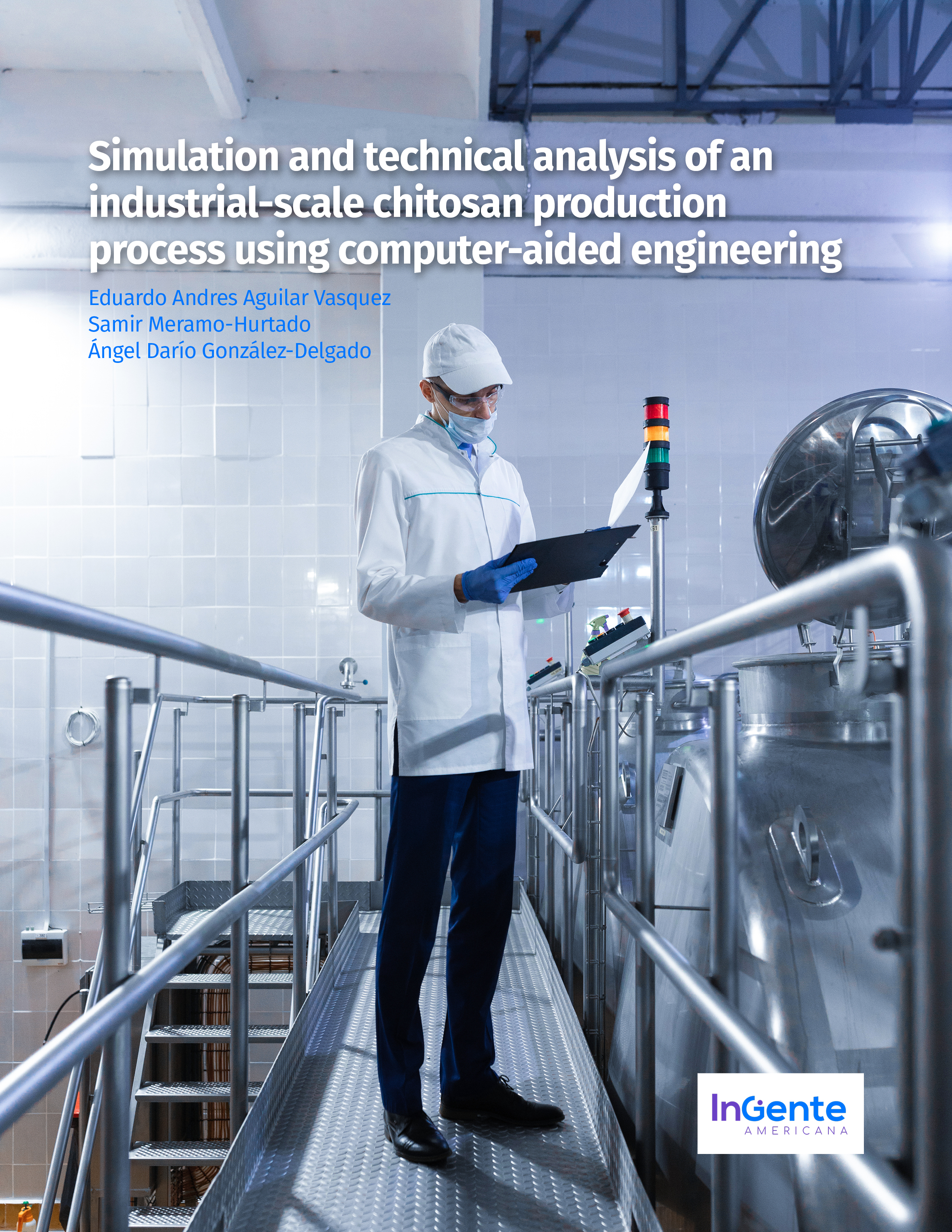Simulation and technical analysis of an industrial-scalechitosan production process using computer-aided engineering
DOI:
https://doi.org/10.21803/ingecana.5.5.903Keywords:
Bioprocess, Circular economy, Process engineering, Computer-aided, ChitosanAbstract
This work aims to simulate and analyze a topology to produce chitosan from shrimp exoskeletons using computer-aided engineering. To achieve this, the commercial simulator Aspen Plus was used to replicate a block diagram based on representative data from the literature and experimental analyses. The simulation resulted in a process that produces 12,152 tons/year of chitosan from 57,000 tons/year of shrimp exoskeletons. Additionally, the simulation was validated by comparing the properties of the chitosan obtained with those reported in the literature. This validation yielded positive results, showing an accuracy above 88%, indicating that the assumptions made for the simulation were appropriate. Furthermore, the technical analysis showed that the process has a significant yield of 210.1 g per kilogram of raw material, along with a considerable technical efficiency of 63.4%. This value suggests that the process efficiently produces chitosan; however, there is still potential for improvement to increase its productivity.
Downloads
References
[1] P. Söderholm, “The green economy transition: the challenges of technological change for sustainability,” Sustain. Earth, vol. 3, no. 1, 2020, doi: 10.1186/s42055-020-00029-y.
[2] S. Spierling et al., “Bio-based plastics - A review of environmental, social and economic impact assessments,” J. Clean. Prod., vol. 185, pp. 476–491, 2018, doi: 10.1016/j.jclepro.2018.03.014.
[3] M. Palmeros Parada, P. Osseweijer, and J. A. Posada Duque, “Sustainable biorefineries, an analysis of practices for incorporating sustainability in biorefinery design,” Ind. Crops Prod., vol. 106, pp. 105–123, 2017, doi: 10.1016/j.indcrop.2016.08.052.
[4] F. A. Vicente et al., “Crustacean waste biorefinery as a sustainable cost-effective business model,” Chem. Eng. J., vol. 442, no. March, 2022, doi: 10.1016/j.cej.2022.135937.
[5] H. El Knidri, R. Belaabed, A. Addaou, A. Laajeb, and A. Lahsini, “Extraction, chemical modification and characterization of chitin and chitosan,” Int. J. Biol. Macromol., vol. 120, pp. 1181–1189, 2018, doi: 10.1016/j.ijbiomac.2018.08.139.
[6] H. Zhang, S. Yun, L. Song, Y. Zhang, and Y. Zhao, “The preparation and characterization of chitin and chitosan under large-scale submerged fermentation level using shrimp by-products as substrate,” Int. J. Biol. Macromol., vol. 96, pp. 334–339, 2017, doi: 10.1016/j.ijbiomac.2016.12.017.
[7] I. Leceta, P. Guerrero, S. Cabezudo, and K. De La Caba, “Environmental assessment of chitosan-based films,” J. Clean. Prod., vol. 41, pp. 312–318, 2013, doi: 10.1016/j.jclepro.2012.09.049.
[8] S. Kumari, P. Rath, A. Sri Hari Kumar, and T. N. Tiwari, “Extraction and characterization of chitin and chitosan from fishery waste by chemical method,” Environ. Technol. Innov., vol. 3, pp. 77–85, 2015, doi: 10.1016/j.eti.2015.01.002.
[9] P. S. Bakshi, D. Selvakumar, K. Kadirvelu, and N. S. Kumar, “Chitosan as an environment friendly biomaterial – a review on recent modifications and applications,” Int. J. Biol. Macromol., vol. 150, pp. 1072–1083, 2020, doi: 10.1016/j.ijbiomac.2019.10.113.
[10] P. Pal, A. Pal, K. Nakashima, and B. K. Yadav, “Applications of chitosan in environmental remediation: A review,” Chemosphere, vol. 266, p. 128934, 2021, doi: 10.1016/j.chemosphere.2020.128934.
[11] V. B. Agbor, N. Cicek, R. Sparling, A. Berlin, and D. B. Levin, “Biomass pretreatment: Fundamentals toward application,” Biotechnol. Adv., vol. 29, no. 6, pp. 675–685, 2011, doi: 10.1016/j.biotechadv.2011.05.005.
[12] S. Meramo, A. Gonzalez-Quiroga, and A. Gonzalez-Delgado, “Technical, Environmental, and Process Safety Assessment of Acetone-Butanol-Ethanol Fermentation of Cassava Residues,” Sustain., vol. 14, no. 23, 2022, doi: 10.3390/su142316185.
[13] S. I. Meramo-Hurtado, K. Moreno-Sader, and A. D. González Delgado, “Evaluación ambiental de la producción a larga escala de microperlas de quitosano modificadas con tiourea como alternativa de valorización de residuos en el sector camaronicultor,” Prospectiva, vol. 18, no. 1, pp. 1–6, 2020, doi: 10.15665/rp.v18i1.2100.
[14] X. Mao, N. Guo, J. Sun, and C. Xue, “Comprehensive utilization of shrimp waste based on biotechnological methods: A review,” J. Clean. Prod., vol. 143, pp. 814–823, 2017, doi: 10.1016/j.jclepro.2016.12.042.
[15] L. Jacquemin, P. Y. Pontalier, and C. Sablayrolles, “Life cycle assessment (LCA) applied to the process industry: A review,” Int. J. Life Cycle Assess., vol. 17, no. 8, pp. 1028–1041, 2012, doi: 10.1007/s11367-012-0432-9.
[16] Z. D. King, “Aspen simulation of furfural and hydroxymethylfurfural production from biomass,” p. 63, 2014.
[17] W. C. Silva, E. C. C. Araújo, C. E. Calmanovici, A. Bernardo, and M. Giulietti, “Environmental assessment of a standard distillery using aspen plus®: Simulation and renewability analysis,” J. Clean. Prod., vol. 162, pp. 1442–1454, 2017, doi: 10.1016/j.jclepro.2017.06.106.
[18] C. Lopes, L. T. Antelo, A. Franco-Uría, A. A. Alonso, and R. Pérez-Martín, “Chitin production from crustacean biomass: Sustainability assessment of chemical and enzymatic processes,” J. Clean. Prod., vol. 172, pp. 4140–4151, 2018, doi: 10.1016/j.jclepro.2017.01.082.
[19] D. A. Trirahayu, “Process simulation of glycerol production from corn oil via transesterification,” IOP Conf. Ser. Mater. Sci. Eng., vol. 830, no. 2, pp. 7–11, 2020, doi: 10.1088/1757-899X/830/2/022011.
[20] J. A. Posada, J. C. Higuita, and C. A. Cardona, “Optimization on the Use of Crude Glycerol from the Biodiesel Production to Obtain Poly-3-Hydroxybutyrate,” Proc. World Renew. Energy Congr. – Sweden, 8–13 May, 2011, Linköping, Sweden, vol. 57, pp. 327–334, 2011, doi: 10.3384/ecp11057327.
[21] C. Espinosa, B. Arrieta, A. D. Gonzalez-Delgado, K. Ojeda, and E. Sanchez, “Technical and environmental evaluation of an integrated biorefinery from Residual biomass of oil palm fruit to obtain biobutanol and biohydrogen,” J. Eng. Appl. Sci., vol. 13, no. 2, pp. 533–540, 2018, doi: 10.3923/jeasci.2018.533.540.
[22] A. Ninõ-Villalobos, J. Puello-Yarce, Á. D. González-Delgado, K. A. Ojeda, and E. Sánchez-Tuirán, “Biodiesel and Hydrogen Production in a Combined Palm and Jatropha Biomass Biorefinery: Simulation, Techno-Economic, and Environmental Evaluation,” ACS Omega, vol. 5, no. 13, pp. 7074–7084, 2020, doi: 10.1021/acsomega.9b03049.
[23] V. Capdevila, V. Kafarov, C. Gely, and A. Pagano, “Simulation of the Fermentation Process To Obtain Bioethanol From Rice Residues,” vol. 6, no. 2, pp. 11–21, 2015.
[24] T. Herrera-Rodríguez, V. Parejo-Palacio, and Á. González-Delgado, “Computer-Aided Simulation of Avocado Oil Production in North Colombia,” Chem. Eng. Trans., vol. 92, no. May, pp. 415–420, 2022, doi: 10.3303/CET2292070.
[25] K. Cogollo-Herrera, H. Bonfante-Álvarez, G. De Ávila-Montiel, A. H. Barros, and Á. D. González-Delgado, “Techno-economic sensitivity analysis of large scale chitosan production process from shrimp shell wastes,” Chem. Eng. Trans., vol. 70, pp. 2179–2184, 2018, doi: 10.3303/CET1870364.
[26] D. Gómez-Ríos, R. Barrera-Zapata, and R. Ríos-Estepa, “Comparison of process technologies for chitosan production from shrimp shell waste: A techno-economic approach using Aspen Plus®,” Food Bioprod. Process., vol. 103, pp. 49–57, 2017, doi: 10.1016/j.fbp.2017.02.010.
[27] H. Bonfante-Alvarez, G. De Avila-Montiel, A. Herrera-Barros, M. Torrenegra-Alarcón, and Á. D. González-Delgado, “Evaluation of five chitosan production routes with astaxanthin recovery from shrimp exoskeletons,” Chem. Eng. Trans., vol. 70, pp. 1969–1974, 2018, doi: 10.3303/CET1870329.
[28] H. Srinivasan, K. Velayutham, and R. Ravichandran, “Chitin and chitosan preparation from shrimp shells Penaeus monodon and its human ovarian cancer cell line , PA-1,” Int. J. Biol. Macromol., vol. 107, pp. 662–667, 2018, doi: 10.1016/j.ijbiomac.2017.09.035.
[29] K. Moreno-Sader, S. I. Meramo-Hurtado, and A. D. González-Delgado, “Environmental sustainability analysis of chitosan microbeads production for pharmaceutical applications via computer-aided simulation, WAR and TRACI assessments,” Sustain. Chem. Pharm., vol. 15, no. December 2019, 2020, doi: 10.1016/j.scp.2020.100212.
[30] J. Monter-Miranda et al., “Extracción y caracterización de propiedades fisicoquímicas, morfológicas y estructualaes de quitina y quitosano,” Rev. Mex. Ing. Química, vol. 15, no. 3, pp. 749–761, 2016.
[31] [E. F. Abadir, N. F. A. Salam, and F. I. Barakat, “Study on Production and Kinetics of Chitosan from Shrimp Shell Waste using Factorial Design Experimental Technique,” J. Adv. Chem. Sci., vol. 5, no. 1, pp. 615–617, 2019, doi: 10.30799/jacs.204.19050103.
[32] S. Zahedi, J. Safaei Ghomi, and H. Shahbazi-Alavi, “Preparation of chitosan nanoparticles from shrimp shells and investigation of its catalytic effect in diastereoselective synthesis of dihydropyrroles,” Ultrason. Sonochem., vol. 40, no. February 2017, pp. 260–264, 2018, doi: 10.1016/j.ultsonch.2017.07.023.
[33] E. Aguilar-Vásquez, M. Ramos-Olmos, and Á. D. González-Delgado, “A Joint Computer-Aided Simulation and Water-Energy-Product (WEP) Approach for Technical Evaluation of PVC Production,” Sustainability, vol. 15, no. 10, 2023, doi: 10.3390/su15108096.
[34] K. A. Moreno-Sader, J. D. Martinez-Consuegra, and Á. D. González-Delgado, “Development of a biorefinery approach for shrimp processing in North-Colombia: Process simulation and sustainability assessment,” Environ. Technol. Innov., vol. 22, p. 101461, 2021, doi: 10.1016/j.eti.2021.101461.
[35] A. Zuorro, K. A. Moreno-Sader, and Á. D. González-Delgad, “Inherent safety analysis and sustainability evaluation of chitosan production from shrimp exoskeleton in Colombia,” Water (Switzerland), vol. 13, no. 4, 2021, doi: 10.3390/w13040553.
[36] S. Meramo-Hurtado, C. Alarcón-Suesca, and Á. D. González-Delgado, “Exergetic sensibility analysis and environmental evaluation of chitosan production from shrimp exoskeleton in Colombia,” J. Clean. Prod., vol. 248, 2020, doi: 10.1016/j.jclepro.2019.119285.
[37] K. A. Moreno-Sader, J. Martínez-Consuegra, and Á. D. González-Delgado, “An integrated biorefinery approach via material recycle/reuse networks for the extraction of value-added components from shrimp: Computer-aided simulation and environmental assessment,” Food Bioprod. Process., vol. 127, pp. 443–453, 2021, doi: 10.1016/j.fbp.2021.04.003.
[38] F. L. Muñoz et al., “Insights from an exergy analysis of a green chemistry chitosan biorefinery,” Chem. Eng. Res. Des., vol. 194, pp. 666–677, 2023, doi: 10.1016/j.cherd.2023.04.038.
[39] Á. D. González-Delgado, K. A. Moreno-Sader, and J. D. Martínez-Consuegra, “Sustainable Biorefining of shrimp: Developments from Computer Aided Process Engineering (In Spanish).” Corporación Universitaria Minuto de Dios - UNIMINUTO, 2022, doi: 10.26620/uniminuto/978-958-763-558-4.
[40] S. Meramo, Á. D. González-Delgado, S. Sukumara, W. S. Fajardo, and J. León-Pulido, “Sustainable design approach for modeling bioprocesses from laboratory toward commercialization: Optimizing chitosan production,” Polymers (Basel)., vol. 14, no. 1, 2022, doi: 10.3390/polym14010025.
[41] I. O. Saheed, W. Da Oh, and F. B. M. Suah, “Chitosan modifications for adsorption of pollutants – A review,” J. Hazard. Mater., vol. 408, no. December 2020, p. 124889, 2021, doi: 10.1016/j.jhazmat.2020.124889.J. U. Duncombe, “Infrared navigation—Part I: An assessment of feasibility (Periodical style),” IEEE Trans. Electron Devices, vol. ED-11, pp. 34–39, Jan. 1959.

Downloads
Published
Issue
Section
License
Copyright (c) 2025 Eduardo Andres Aguilar Vasquez, Samir Meramo-Hurtado, Angel Darío González Delgado

This work is licensed under a Creative Commons Attribution 4.0 International License.





